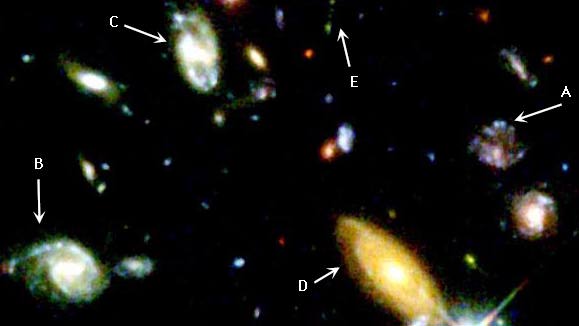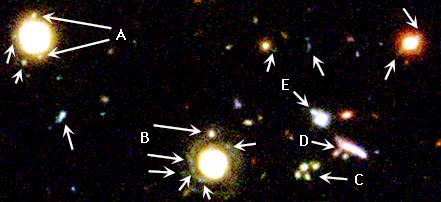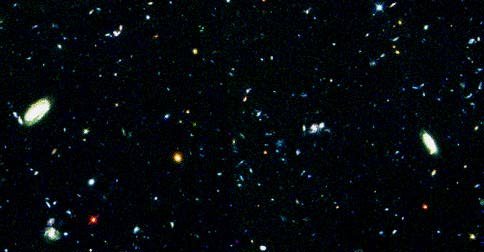The traditional theory of galaxy formation has many problems. One major problem is the traditional theory assumes without doubt that galaxies are formed by collapsing clouds of primordial gas and dust. If this were true, then where is direct evidence of these hypothetical clouds?
The further away an object in space appears, the further back in time it is observed. If primordial gas and dust existed, then extremely massive clouds of the material should be visible in the best, most distant views of galaxies. The best known of deep space images is the Hubble Deep Field View. If you are an astronomer, then you already know the problems this image poses. If you are unfamiliar with this image it shows exactly the opposite of what traditional theory predicted.
The entire Deep Field View is too large to reproduce at this web site. To download the entire image go to www.oposite.stsci.edu. A portion of the image is shown below.

I could spend quite a long time discussing this image, but the key question is why are any details visible at all? This image supposedly looks back 80 percent of the way back to the beginning of the Big Bang. The expected massive clouds of primordial gas and dust should be obscuring the view. Granted, there may be some details we can not see due to some clouds of gas and dust, but they are not the extremely massive clouds that are expected from the traditional theory if they are in this image! Note the fine details of the galaxies. Note galaxy "A" and the details of its structure. Note the details in "B," in "C," in "D," and in "E." Granted, these objects and bigger and therefore probably closer. But also note all the small blue galaxies. If they where behind massive clouds of primordial dust and gas would they be blue? They should be reddened by the dust. They are small partly because of their distance. A large cloud certainly would block a small galaxy. Should these galaxies even be visible?

This is another section of the Deep Field View. Again, note the details of the structures. Note the evidence that galaxies are decaying balls-of-light. Note the ejected balls-of-light from the galactic cores. Note how the objects are decaying into smaller balls-of-light.
In another famous image, scientists studied young galaxies. This image does not look as far back in time as the Deep Field View. In general, the galaxies in this image were small and blue, with no apparent veiling or reddening by massive clouds of primordial dust and gas.

The answer to the question, "Where is the dust?" is:
The Ball-of-Light Particle Model predicts the universe started exploding in a "Big Bang" explosion. However, it predicts that the explosion initiated from a massive ball-of-light. This ball-of-light decayed by splitting into two, thus explaining why our half of the universe appears predominantly right-handed. When this decay occurred, it almost certainly made some of the cosmic background radiation and left behind some clouds of gas and dust, but the cause and effect are backwards. The gas and dust were made by a decaying ball-of-light.
The Ball-of-Light Particle Model predicts that when the two halves of the universe themselves exploded into smaller balls-of-light, they almost certainly made additional cosmic background radiation and left behind some clouds of gas and dust, but again, the cause and effect are backwards. The gas and dust were made by decaying balls-of-light.
The Ball-of-Light Particle Model predicts that when the remnant balls-of-light decayed further, they again left behind additional cosmic background radiation and additional gas and dust, but they were made by decaying balls-of-light. For example, see also Gamma Ray Bursts.
(See also, Quasars) Studies of distant Quasars appear to reveal that there are clouds of gas and dust in the intervening regions. Are they examples of left over massive clouds of primordial gas and dust if we can even see the Quasars? I believe the answer is no, otherwise the distant Quasars would not even be visible.
Scientists have studied how galaxies cluster. This is a critical issue. If the universe formed from a primordial cloud of gas and dust, then there must have been a significant amount of time between when the "mere one-part-per-hundred-thousand" of ripples in the density of the original cloud allowed gravity to collapse the clouds: into stars; into galaxies; into clusters of galaxies; and then into superclusters of galaxies. How much time was required for this to happen? The further away scientists find superclusters, the more difficult it is to back the theory of a primordial cloud of gas and dust.
"Now a group of astronomers conducting a deep redshift survey has hit on a large cluster that existed only about a billion years after the Big Bang, at a redshift z of 3.09. Charles Steidel (Palomar Observatory) and his colleagues found the grouping in a survey field in Aquarius using the Palomar Mountain 5-meter reflector and the twin Keck 10-meter telescopes atop Mauna Kea. As they report in the Astrophysical Journal for January 10th, 15 luminous galaxies and a quasar are bunched essentially the same redshift. The galaxies are about 24th magnitude, and they span an are at least 40 million light-years wide. Since they are so strongly grouped, they are probably the forerunners of the giant, trillion-solar-mass galaxies that highlight clusters today. How the universe grew so clumpy so soon after the almost perfectly smooth Big Bang remains one of astronomy's outstanding mysteries."
Sky and Telescope, January 1998, page 22
How much gas and dust is enough?
You might start wondering how large would the clouds of gas and dust have to be to be big enough to qualify as the proverbial "primordial clouds of gas and dust"? Let's start with something everyone can visualize -- a house fire. Picture a house fire! Picture the black smoke billowing out of the fire. Have you ever seen a fire safety video of what a "flash over" looks like? This is the point where a room on fire essentially bursts into flames. The smoke produced at this point is amazing! Have you ever heard how difficult it is for firefighters to see through the smoke of a house fire? Often, they can not even see their hand in front of their face. In other words, it doesn't take much smoke and soot to block the light of the fire. How much mass would you guess was in that smoke and soot? How much do think that smoke weighs? It takes a very small volume of mass to completely block light at optical wavelengths. Imagine how much mass is in a star like our "little" sun. Imagine our sun's mass spread out in a cloud of gas and dust with just enough density to completely block light -- similar to the density of the smoke and soot in a house fire. How big of a volume of space would that be? I don't know the answer. If you have the skill to calculate this, then please E-mail me your answer and I will post it.
Again, I don't know the answer to the above question. However, imagine all of the mass of a galaxy like ours spread out into a volume of space so that the density was just enough to prevent light to pass through then entire cloud? That would be a cloud of gas and dust larger than any I have ever seen in any image from space! Now imagine a cloud formed by just the galaxies in our local group. I am sure the volume of space it would fill would be hundreds of thousands if not millions of times the volume of our local group.
Keep in mind, the further back in time you view objects in space, the closer they were in proximity to each other because the universe was much smaller earlier in the Big Bang.
Gas and Dust in the Arms of Galaxies
Scientists have used the Hubble Space Telescope to image portions of some galaxies that appear in front of another galaxy. The galaxy in the background acts as a "back light" for the galaxy in the foreground. A portion of one such image is shown below. (To see: the entire image, related press releases, and related science, then go to the Hubble Space Telescope web site at www.oposite.stsci.edu.)
In this image, a spiral galaxy is in the foreground on the left, and an elliptical galaxy is in the background on the right. Scientists have often imagined that the arms of spiral galaxies are so thick with gas and dust that you couldn't even see through them. This is not the case in this image. Is this typical? Are all galaxies this transparent? It is still too early to be certain. However, in this example, there is not a lot of gas and dust here -- not by the standards of "massive primordial clouds" of gas and dust at least.
Another image from the same study looks like:
Again, a dusty spiral arm is backlit by an elliptical. Again, the dust and gas is not very thick.
Galaxy Formation
The Ball-of-Light Particle Model predicts that the core of a galaxy is a decaying ball-of-light that is ejecting stars. The stars may be ejected in a spherical halo -- as in a spherical galaxy, or as in the bulge of a spiral galaxy. The stars may be ejected in streams -- as in the arms of spiral galaxies. As the stars travel, they leave behind dust trails. As these stars slow, they decay faster and sometimes explode in Zones of Instability. As the stars decay they leave behind dust and gas. To summarize, the Ball-of-Light Particle Model predicts:
The cores of stars create the dust and gas -- not dust and gas creates stars and galaxies.
The Towers of M16
The "Towers" or "Pillars" of M16 are famous in astronomy. Some astromers point to these dust structures as proof that stars come from collapsed clouds of dust. However, this image proves just the opposite, decaying balls-of-light--i.e., the core's of stars--are making the dust. Recently, 7/15/2001, at the Universe 2001 Expo, I was able to listen to a presentation given by Jeff Hester. Jeff Hester is the astromer who took the image of the Towers of M16 below. During his presentation, Jeff reiterated the standard view that these pillars are collapsed clouds of dust, forming stars, and that pillar shapes are formed from the radiation of stars just out of site, off the edge of the image. I asked him if there were any recent infared images of these pillars showing what is going on inside. He and Virginia Trimble said there were, and that there were some really strange things going on inside. Jeff also gave the analogy of the eroding geological structures in the southwest United States. This analogy does not work though. Any common sense observation of these roughly parallel pillars shows that there are not enough surrounding stars, aligned in the proper geometry, to carve out, or erode these pillars. These pillars have many spikes sticking out in many directions. Are we led to believe that some star's radiation erode the overall pillar shapes, while the radiation from other stars stars erode the smaller protusions? If you draw axial lines along every protrusion--major and minor--then it obviously impossible for the radiation from any group of stars to form these complex structures. I am not saying that the radiation from other stars has no role in forming these structures. What I am saying, is that these objects are created from decaying balls-of-light. As the balls-of-light decay, breaking apart into smaller particles, they create the dust trails. Small bright objects can be seen at the tips of the smaller protrusions, these are exploding off of large decaying balls-of-light travelling along the major towers. I believe that the infared observations, that I have been unable to discover but now know for a fact to exist, will agree with my controversial view and not the traditional view.
When the space shuttle Challenger exploded, it left behind structures similar to these towers. Do you recall the shuttle disaster? What is your opinion of these structures? Do the towers of M16 resemble tumbling exploding objects, or collapsing clouds of gas and dust?
To summarize, the Ball-of-Light Particle Model predicts these structures are examples of the dust and gas left behind by decaying balls-of-light. (See also, The Towers of M16 for a complete explanation.) By the way, note how little material -- in volume -- is needed to completely obscure our view.
The Twisters in the Lagoon Nebula
Another famous Hubble Space Telescope image is of the M8, also called the Lagoon Nebula.
This is a beautiful image. The obvious question is, in this image, where is the gas and dust coming from and why does the gas and dust take these beautiful twisting shapes? Where do the streamers come from? Zooming in on the details of the image reveals the answer:
Decaying balls-of-light! Embedded in this beautiful cloud of gas and dust are hundreds -- if not thousands -- of decaying balls-of-light. I am not certain how big these objects are, but my impression is they are much smaller than normal stars. (A larger star is visible in the upper left of the wide angle view.) Anyway, note "A" and how it is at the head of an apparent twisting tower of gas and dust. Note other glowing balls-of-light at: B, C, D, E and at many other points. There is a tower similar to the towers in M16 at "F." There are apparent balls-of-light around "G" that do not appear to be decaying yet. (It is possible they are more distant stars.)
(See also, Decaying balls-of-light in the Helix Nebula for similar examples of decaying balls-of-light.)